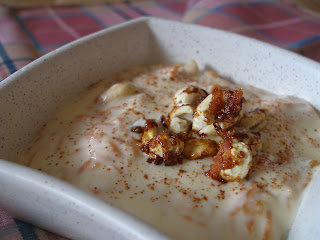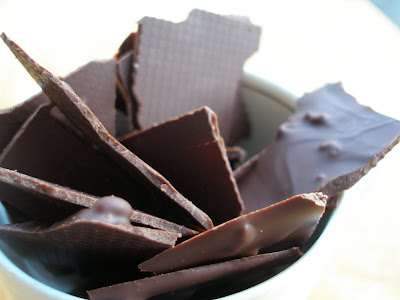I've heard from different sources that every Estonian makes pasha (pashka) at Easter. What? Really? The first time ever I heard about this traditional dessert was some four years ago when I was accidentally watching a Russian TV show
Subboteja on one of the Estonian TV channels. I asked my mom about it. Her description was rather like '
well...it's like...hmm...' than '
it's an Estonian tradition too, you know'.

So I have been associating pasha with the Russians, it's their tradition after all. But recently I've discovered how many people in Estonia actually make it and I mean among the Estonians.
My family has been making it for three years now (we've gotten over this '
well...it's like...hmm...'). But still - to discuss it as a traditional Estonian Easter dessert? Don't mention it when I'm around. Nevertheless I like pasha as I love all things made from curd cheese and the recipe we chose this year was a true hit. Custard is not a very usual component in pasha, but it might turn into one at my household!
Pasha with custard(from the April 2006 edition of
Oma Maitse magazine)
100 g butter
3 dl double/single cream
4 eggs
2 1/2 dl sugar
1 tbsp vanilla sugar
1 dl raisins
1 dl candied citrus peel or marmalade
1 dl almonds
500 g curd cheese
+ extra raisins/almonds/candied peel for decorating
for draining:
a special pasha mold/large sieve/flowerpots with holes in the bottom
cheesecloth
1. Prepare the almonds. Peel them (you can do so by first 'scaring' them for about half a minute in boiling water, then cooling under cold water and gently pressing the peels off between two fingers), roast them on a dry pan or in the oven (about 5 minutes at 200C) until golden and chop.
2. Using an electric mixer, beat the eggs and sugar until fluffy. Melt butter in a saucepan, add cream. Then add the egg mixture into the saucepan and start heating it up, whisking constantly until the mixture thickens (don't let it reach the boiling point!). Add vanilla and let the custard cool.
3. Press the curd cheese through a sieve if it's not smooth and then add raisins, chopped almonds, candied peel or marmalade and custard to it.


4. Rinse the cheesecloth carefully with hot water and then use it to line the mold you've chosen. Pour the curd cheese mixture into the mold and cover it with cheesecloth. Place something heavy over the top to fasten the thickening process and let the dessert stand in the fridge for at least 8 hours.
5. For serving - turn the mold over and decorate with raisins, almonds, candied peel, marmalade or with whatever else you want.


Want a definition to
rich food? I guess this is it, this is the one. But it's really good. Moderately firm, but silky on the tongue, with bits of roasted almonds that crunch between the teeth. The mild custard challenges the sourness of curd cheese and finally wins, but with the help of sugary marmalade that almost melts itself into one's bite when bitten.
But yes, it's rich. What if I discarded double cream and used milk instead? And what if I accidentally forgot to add that huge amount of butter? Would it still taste heavenly? I mean...everybody loves the taste of
fat (even when they don't admit it), but I do think people wouldn't mind if I broke some rules. Even pasha might like the feeling of being slim:)

 These muffins are created for the event Muffin Monday #2 - Muffins that Make you go *Ooooh!* hosted by Experiments.
These muffins are created for the event Muffin Monday #2 - Muffins that Make you go *Ooooh!* hosted by Experiments.










































